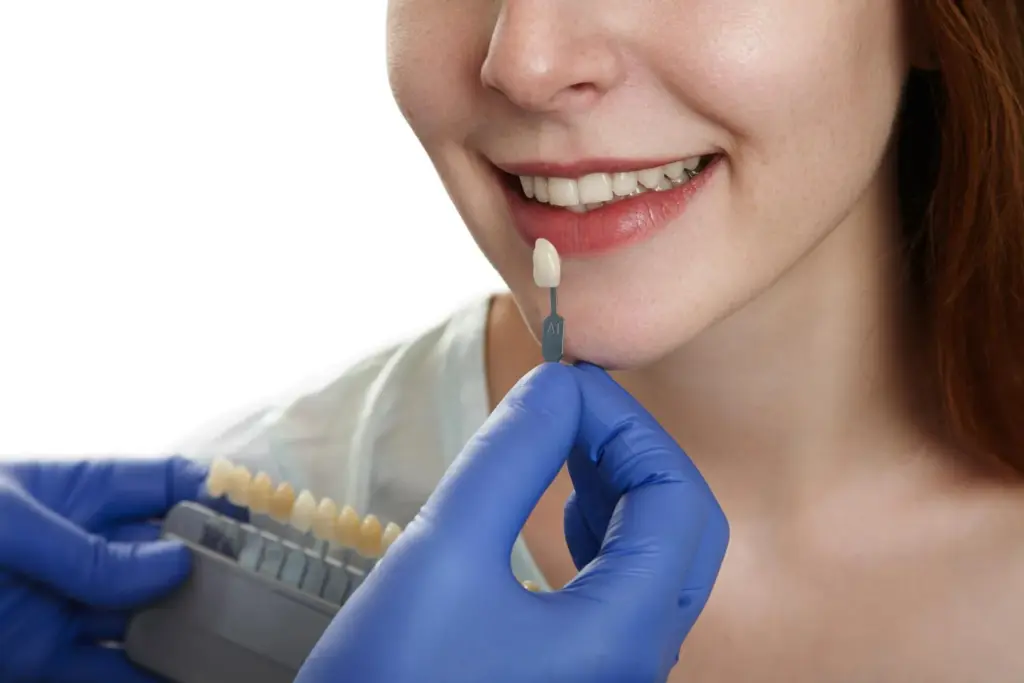Composite bonding is an innovative and popular cosmetic dental treatment designed to enhance the appearance of your teeth. Whether you’re dealing with chips, gaps, or discolouration, composite bonding can provide a quick and minimally invasive solution.
This comprehensive guide explores everything you need to know about the procedure, what to expect in terms of discomfort, and how it compares to other treatments.
What Is Composite Bonding?

Composite bonding is a cosmetic procedure where a tooth-coloured resin is applied directly to your teeth to correct minor imperfections. The resin is shaped to blend naturally with your existing teeth, restoring both appearance and function. The procedure is often completed in one appointment and involves little to no alteration of the natural tooth structure, making it a conservative and reversible option compared to alternatives like veneers or crowns.
Composite bonding is not just a quick fix; it offers both functional and aesthetic benefits. It can strengthen teeth affected by small chips and cracks and significantly enhance the harmony of a person’s smile. Because the materials used mimic natural enamel, the final result looks very realistic.
Suitable Candidates for Composite Bonding
- Individuals with small chips or cracks
- Patients with mild to moderate tooth discolouration
- Those with small gaps between teeth
- People looking for a minimally invasive cosmetic solution
- Patients with good overall oral health
Not Ideal for:
- People with bruxism (teeth grinding)
- Individuals with significant decay or damage
- Cases requiring substantial structural restoration (e.g.,dental bridges)
- Patients with poor oral hygiene or gum disease
Preparing for Your Appointment
The first step is a consultation with one ofour dental professionals, where your oral health is assessed, and your desired outcome is discussed.
This appointment typically includes:
- A full oral health check-up
- X-rays or digital imaging to evaluate the teeth in question
- Discussion of your aesthetic goals
- Shade matching using advanced technology
We may also take photos to help plan the changes and ensure the final result blends seamlessly with your existing smile. Our team will provide you with a detailed breakdown of what to expect before, during, and after the procedure.
We may recommend lifestyle adjustments before the procedure, such as avoiding highly pigmented foods or stopping smoking, to optimise results. For anxious patients,sedation options are also available.
What to Expect During the Procedure
The treatment is usually completed in one visit and typically takes between 30 and 60 minutes per tooth.
Step 1: Cleaning and Etching
We begin by thoroughly cleaning the tooth to remove plaque and debris. The enamel is gently roughened to prepare it for bonding. This helps the resin adhere more securely.
Step 2: Bonding Agent
A liquid adhesive is applied to the etched surface and cured using a special light. This forms a solid base for the resin to bond with the natural tooth.
Step 3: Composite Resin Application
The resin is placed onto the tooth in layers and carefully sculpted to match its natural contours. Each layer is shaped before curing, allowing us to achieve a precise form.
Step 4: Curing
The resin is hardened using a curing light to secure it in place. This ensures durability and a strong bond.
Step 5: Shaping and Polishing
Once cured, we refine the shape for a comfortable bite and polish the tooth to a natural, glossy finish. The polishing stage is essential for creating a lifelike enamel sheen.
Does Composite Bonding Hurt?

One of the most frequent questions patients ask is whether the procedure is painful. The answer is reassuringly simple, composite bonding is typically pain-free.
Why It’s Comfortable
- Non-invasive: No drilling or enamel removal required
- Anaesthesia is often unnecessary: Discomfort is minimal for most patients
- Mild sensitivity possible: Temporary pressure or temperature sensitivity may occur
- Options for anxious patients: If you’re sensitive or nervous, digital anaesthesia or sedation is available
Around 36% of UK adults experience moderate levels of dental anxiety, with about 12% reporting dental phobia, according toNHS England’s clinical guide for dental anxiety management. If you’re in this group, rest assured, your comfort is a priority.
Most patients report feeling only minor pressure during the etching and curing stages. Those who do experience sensitivity typically find that it resolves within a few hours post-treatment.
How Long Does Composite Bonding Last?
Composite bonding can last between 5 and 7 years, depending on lifestyle and oral care. With proper maintenance, some patients retain their bonding for over a decade.
Factors That Influence Longevity
- Avoiding hard foods: Biting on pens, nails, or ice can cause chips
- Wearing a nightguard: If you grind your teeth at night (bruxism)
- Managing staining habits: Dark drinks likecoffee or red wine can discolour bonding material
- Good oral hygiene: Regular brushing, flossing, and check-ups are essential
It’s also advisable to attend biannual dental visits for professional polishing and early intervention if signs of wear or damage appear.
Achieving a Natural Look
The materials and techniques used in composite bonding are designed to blend beautifully with your existing smile. Our skilled team works with meticulous precision to ensure your bonding looks natural and is indistinguishable from your real teeth.
Key Aesthetic Details
- Shade matching: Tailored resin colour for a seamless result
- Natural translucency: To mimic the light-reflecting properties of real enamel
- Digital planning tools: Pre-treatment simulations help visualise the outcome and are helpful when planning asmile makeover)
Composite bonding can also be combined with other aesthetic treatments such asteeth whitening ororthodontics for a more comprehensive transformation.
Comparing Composite Bonding to Other Cosmetic Options
Composite bonding is often weighed against other cosmetic treatments such as veneers, whitening and implants.
| Treatment | Advantages | Considerations |
| Composite Bonding | Quick, non-invasive, reversible | May stain over time; moderate lifespan |
| Porcelain Veneers | Stain-resistant, longer-lasting | Requires enamel removal; higher cost |
| Teeth Whitening | Non-invasive and affordable | Doesn’t address physical damage or gaps |
| Dental Implants | Permanent, functional solution | Surgical procedure; higher investment |
Composite bonding is best suited for patients looking to make subtle but impactful changes. It’s also ideal for younger patients or those not ready to commit to more invasive treatments.
Aftercare for Composite Bonding
Looking after your bonded teeth helps maintain their appearance and function. A proper oral hygiene routine is crucial, as is being mindful of certain lifestyle habits.
Best Practices
- Wait one hour before eating or drinking post-treatment
- Brush twice daily with non-abrasive toothpaste
- Floss carefully to avoid loosening the bonded resin
- Use a straw for dark beverages to reduce staining
- Schedule regular dental visits for maintenance and polishing
Avoiding tobacco products can also help preserve the colour and integrity of the composite material. If your bonding becomes stained or damaged, your dentist can easily repair or touch up the affected area without replacing the entire restoration.
Final Thoughts
Composite bonding is a quick, effective, and minimally invasive solution for improving the appearance of your smile. At Chatsworth Dental, we take the time to ensure your experience is as comfortable and pleasant as possible. Our team uses the latest techniques and materials to provide results that last, helping you achieve a beautiful, natural-looking smile. Ready to enhance your smile with composite bonding?Book a consultation with our expert team at Chatsworth Dental today. We’ll be happy to discuss your treatment options and help you achieve the smile you’ve always wanted.
